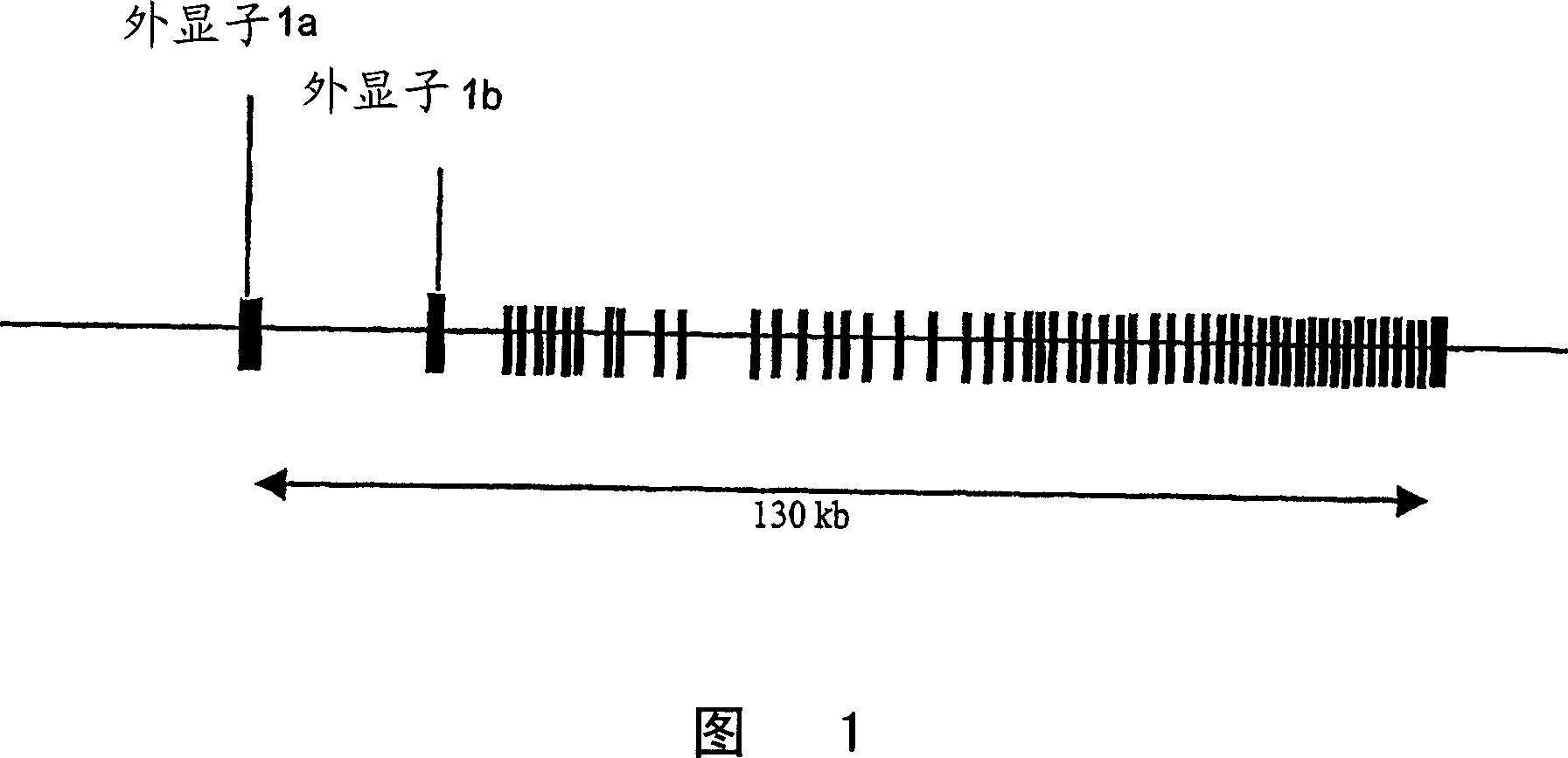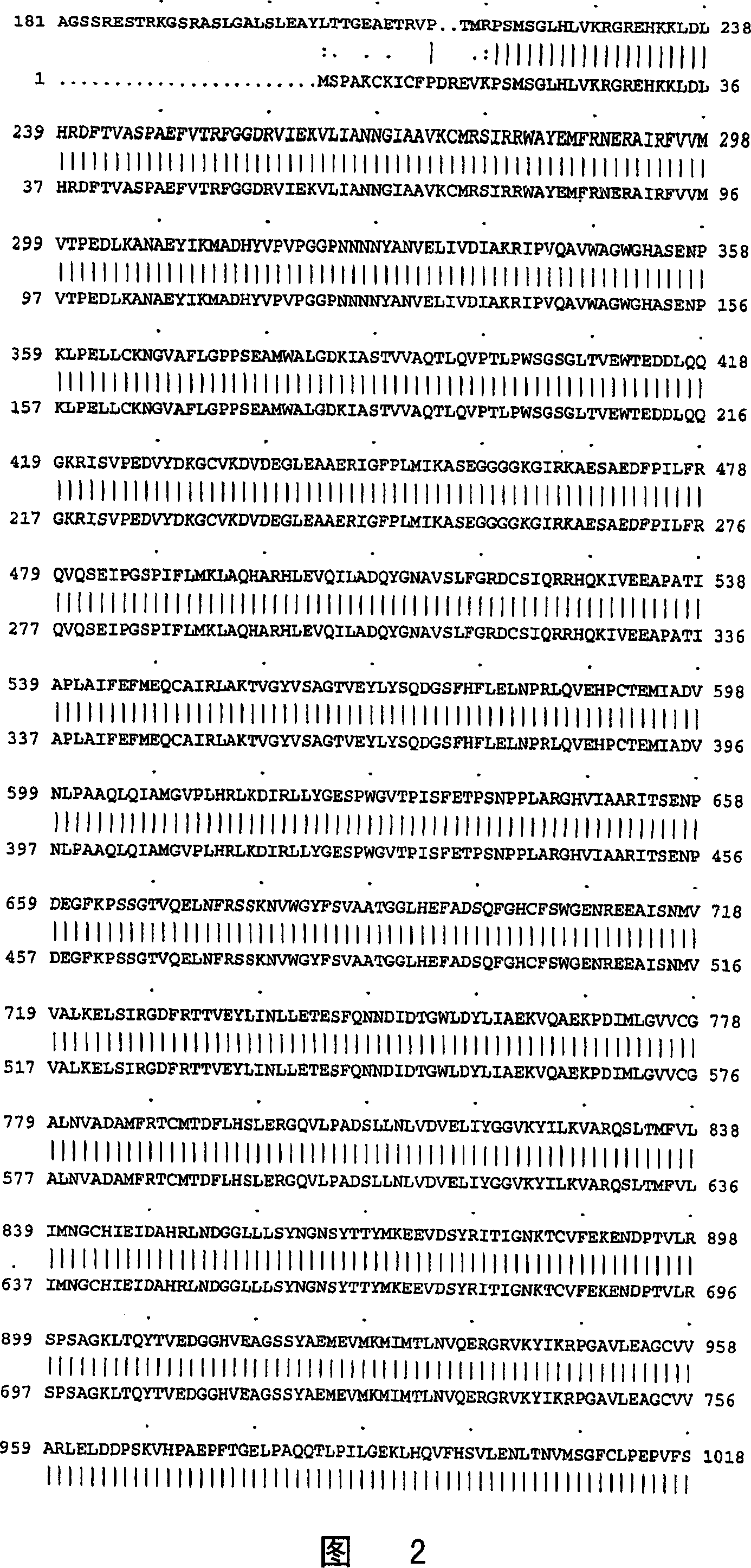Acetyl CoA carboxylase splice variant and uses thereof
A variant, compound technology, applied in the field of isolated nucleic acid molecules, which can solve problems such as unclear mechanism
- Summary
- Abstract
- Description
- Claims
- Application Information
AI Technical Summary
Problems solved by technology
Method used
Image
Examples
Embodiment 1
[0110] In silico (insilico) prediction of a novel splice variant ACC2(1b) of human acetyl-CoA carboxylase 2
[0111] Using a combination of new sequence information and in silico prediction methods, the sequence of a new splice variant of human ACC2 was identified. For EMBL entries containing human genomic DNA, blast the human ACC2 EMBL entry HSU89344 (Blast2 NCBI). The human BAC clone RCPI11-443D10 from chromosome 12 was found to contain the gene encoding human ACC2. The genome sequence of this clone was found in EMBL entry AC007637.
[0112] Using the alignment between HSU89344 and AC007637, the gene structure of human ACC2 was analyzed. Using alignments, exons are predicted, and using intron splice consensus sites, accurate exon boundaries are predicted. Alignment shows that the human ACC2 gene consists of 52 coding exons. Between the sequence of HSU89344 and the genome sequence of AC007637, multiple mismatches were found. The corrected sequence of human ACC2 was gener...
Embodiment 2
[0122] Cloning of human ACC2
[0123] To develop a method for the production of recombinant ACC2, cDNA encoding human ACC2 was cloned by RT-PCR from human skeletal muscle mRNA. A total of 3 fragments covering the 7.5 kb sequence of ACC2 were PCR amplified and multiple clones were sequenced.
[0124] The first fragments 1 to 3925 were PCR amplified from a human cardiac cDNA library using the proofreading polymerase pfu (Stratagene). The primers used in PCR were 5'-ATGGTCTTGCTTCTTTGTCTATC-3' (SEQ ID NO: 6) as a forward primer and 5'-GGCTGTTTAACACATAGGCGA-3' (SEQ ID NO: 7) as a reverse primer. The product was cloned into "TA" cloning vector pCR2.1, transformed into Escherichia coli (E.coli) XL-10 Gold cells (Stratagene), and subjected to complete double-strand sequencing.
[0125] The second and third fragments, 3250 to 5356 bp and 5335 to 7302 bp, were PCR amplified from human skeletal muscle cDNA using Taq-plus Precision (Stratagene), respectively. For the second PCR fragmen...
Embodiment 3
[0131] TaqMan analysis of human tissue confirms the presence of ACC2(1b) transcripts
[0132] Oligonucleotide primers and probes for hACC2(1b) were designed using Primer Express 1.5 software (Applied Biosystems). Design of forward primer 5'-AGTCCTGCCAAGTGCAAGATCT-3' (SEQ ID NO: 12), reverse primer 5'-TCTGTGCAGGTCCAGCTTCTT-3' (SEQ ID NO: 13) and FAM-labeled probe 5'-TGATCGCGAAGTAAAGCCGAGCATGT-3' (SEQ ID NO: 14) to cover exon 1B and exon 2. Human acid ribosomal phosphoprotein (h36B4) primer and VIC-labeled probe were used as endogenous controls.
[0133] First-strand cDNA was synthesized using SuperscriptIII (Invitrogen) and oligoDt primers from 100 ng polyA+RNA (adipose tissue) and 1 μg total RNA (cardiac muscle, skeletal muscle and liver). To determine the expression of ACC2(1b) in human cardiac muscle (Ambion), skeletal muscle (Ambion), liver (BD Biosciences) and adipose tissue (BD Biosciences), real-time PCR (ABI prism 7500 detection system, Applied Biosystems) was used. ...
PUM
 Login to View More
Login to View More Abstract
Description
Claims
Application Information
 Login to View More
Login to View More - R&D
- Intellectual Property
- Life Sciences
- Materials
- Tech Scout
- Unparalleled Data Quality
- Higher Quality Content
- 60% Fewer Hallucinations
Browse by: Latest US Patents, China's latest patents, Technical Efficacy Thesaurus, Application Domain, Technology Topic, Popular Technical Reports.
© 2025 PatSnap. All rights reserved.Legal|Privacy policy|Modern Slavery Act Transparency Statement|Sitemap|About US| Contact US: help@patsnap.com



